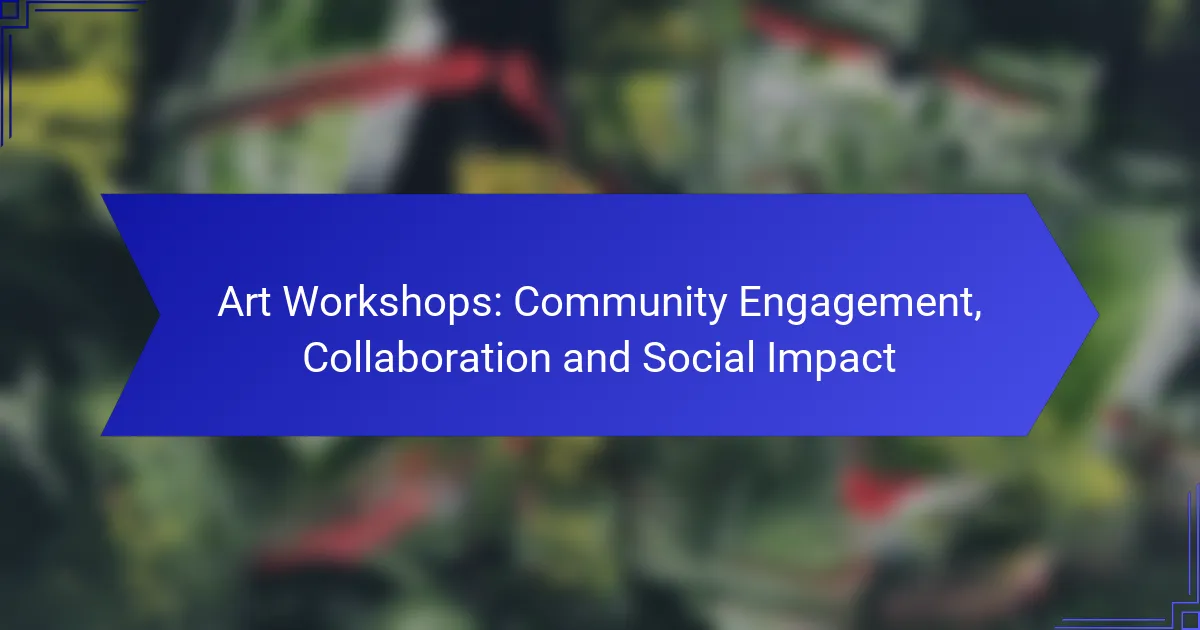Art workshops serve as vital platforms for community engagement, fostering collaboration and creativity among residents in urban areas. By encouraging participation and self-expression, these workshops not only build relationships but also empower individuals to address social issues and promote positive change within their communities.
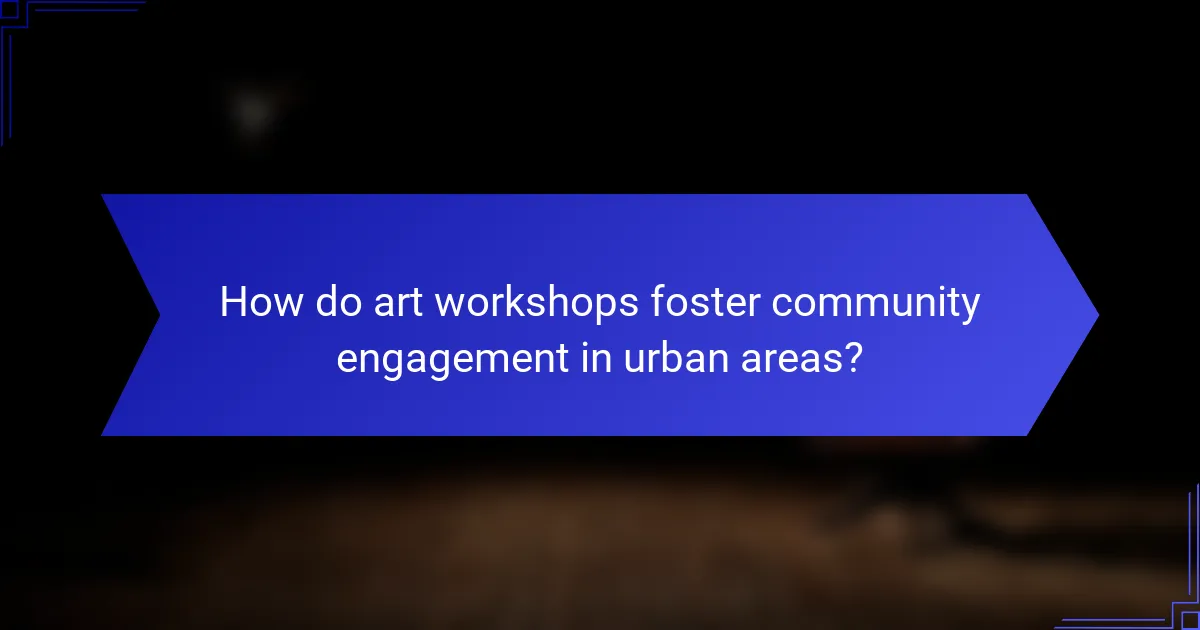
How do art workshops foster community engagement in urban areas?
Art workshops play a crucial role in fostering community engagement in urban areas by creating spaces for collaboration, creativity, and connection among residents. These workshops encourage participation, allowing individuals to express themselves while building relationships with their neighbors.
Increased social interaction
Art workshops facilitate increased social interaction by bringing together diverse groups of people. Participants often engage in collaborative projects, which can lead to meaningful conversations and friendships that extend beyond the workshop.
For example, a mural project might involve residents from different backgrounds working side by side, fostering a sense of camaraderie and shared purpose. This interaction can help break down social barriers and create a more cohesive community.
Strengthened local identity
Art workshops contribute to a strengthened local identity by celebrating the unique culture and history of the area. By incorporating local themes and stories into their projects, participants can express pride in their community.
Workshops that focus on traditional crafts or local art styles can reinforce a sense of belonging and connection to the neighborhood. This shared identity can enhance community spirit and encourage residents to take an active role in local initiatives.
Collaboration with local artists
Collaboration with local artists is a key feature of art workshops that enhances community engagement. Local artists often lead workshops, sharing their skills and knowledge while inspiring participants to explore their creativity.
These collaborations can result in unique community art projects that reflect the collective voice of the residents. Additionally, they provide opportunities for local artists to gain visibility and support, further enriching the cultural landscape of the urban area.
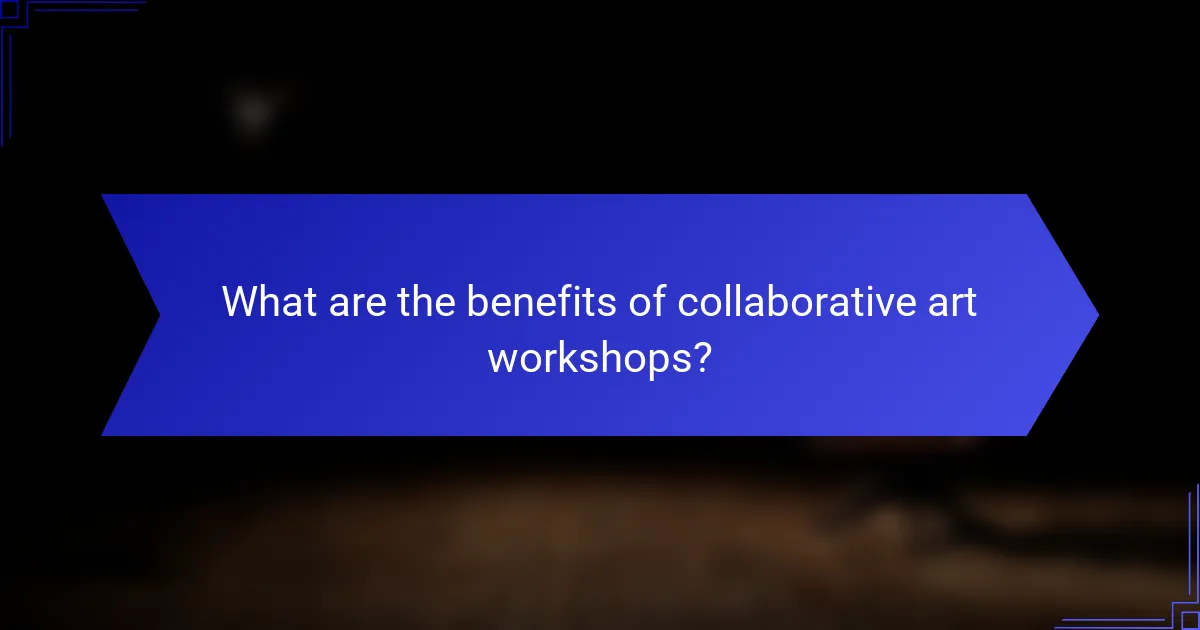
What are the benefits of collaborative art workshops?
Collaborative art workshops offer numerous benefits, including enhanced creativity, skill sharing, and the development of support networks among participants. These workshops foster a sense of community and encourage individuals to express themselves through art while learning from one another.
Enhanced creativity
Collaborative art workshops stimulate enhanced creativity by bringing together diverse perspectives and ideas. When participants work together, they can inspire each other, leading to innovative approaches and unique artistic expressions.
For example, a group of artists might combine different mediums, such as painting and sculpture, resulting in unexpected and exciting outcomes. This cross-pollination of ideas can push individuals beyond their usual creative boundaries.
Skill sharing among participants
Skill sharing is a fundamental aspect of collaborative art workshops, allowing participants to learn from each other’s strengths. Individuals with varying levels of expertise can teach techniques, provide feedback, and offer new insights that enrich the overall experience.
For instance, a novice painter might learn color mixing from a more experienced artist, while the latter could gain fresh perspectives on contemporary themes from their younger counterpart. This exchange not only enhances individual skills but also fosters a collaborative spirit.
Building support networks
Building support networks is a significant benefit of collaborative art workshops, as participants often form lasting connections. These networks can provide emotional support, encouragement, and opportunities for future collaborations.
Participants may find mentors or peers who share similar artistic goals, creating a community that extends beyond the workshop. This sense of belonging can be particularly valuable for emerging artists seeking guidance and motivation in their creative journeys.
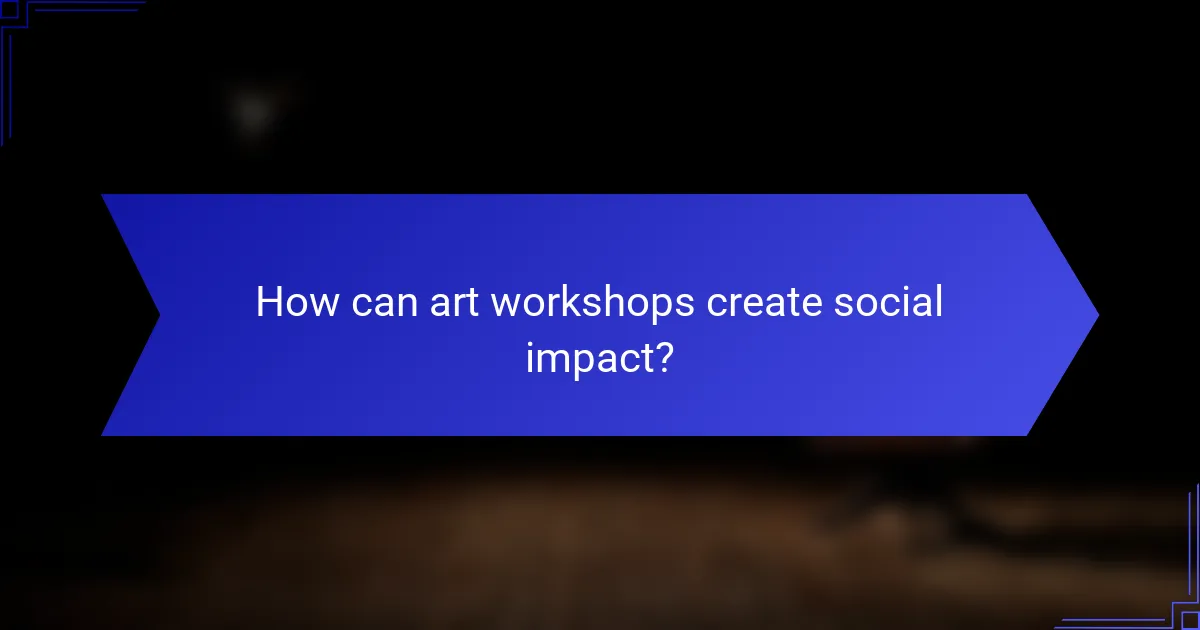
How can art workshops create social impact?
Art workshops can foster social impact by engaging communities, encouraging collaboration, and addressing pressing social issues. Through creative expression, these workshops empower individuals and promote a sense of belonging, ultimately leading to positive change in society.
Empowerment through self-expression
Art workshops provide a platform for individuals to express their thoughts and emotions creatively. This self-expression can enhance personal confidence and foster a sense of ownership over one’s narrative. Participants often find that sharing their art helps them connect with others who share similar experiences.
For example, workshops that focus on storytelling through visual arts can allow participants to explore their identities and share their life stories in a supportive environment. This process not only empowers individuals but also strengthens community bonds.
Addressing social issues through art
Art can serve as a powerful tool for raising awareness about social issues. Workshops that focus on themes like poverty, discrimination, or mental health can encourage participants to reflect on these topics and express their views through various artistic mediums. This engagement can lead to deeper conversations and inspire action within the community.
For instance, mural projects that address local challenges can transform public spaces while sparking dialogue among residents. By visually representing social issues, art workshops can mobilize communities to advocate for change and support initiatives that address these concerns.
Promoting inclusivity and diversity
Art workshops can create inclusive spaces that celebrate diversity and promote understanding among different cultural groups. By bringing together individuals from various backgrounds, these workshops encourage collaboration and the sharing of diverse perspectives. This interaction can help break down barriers and foster mutual respect.
In practice, workshops that incorporate traditional art forms from various cultures can educate participants about different heritages while allowing them to collaborate on projects. This not only enriches the artistic experience but also builds a more cohesive community that values inclusivity.
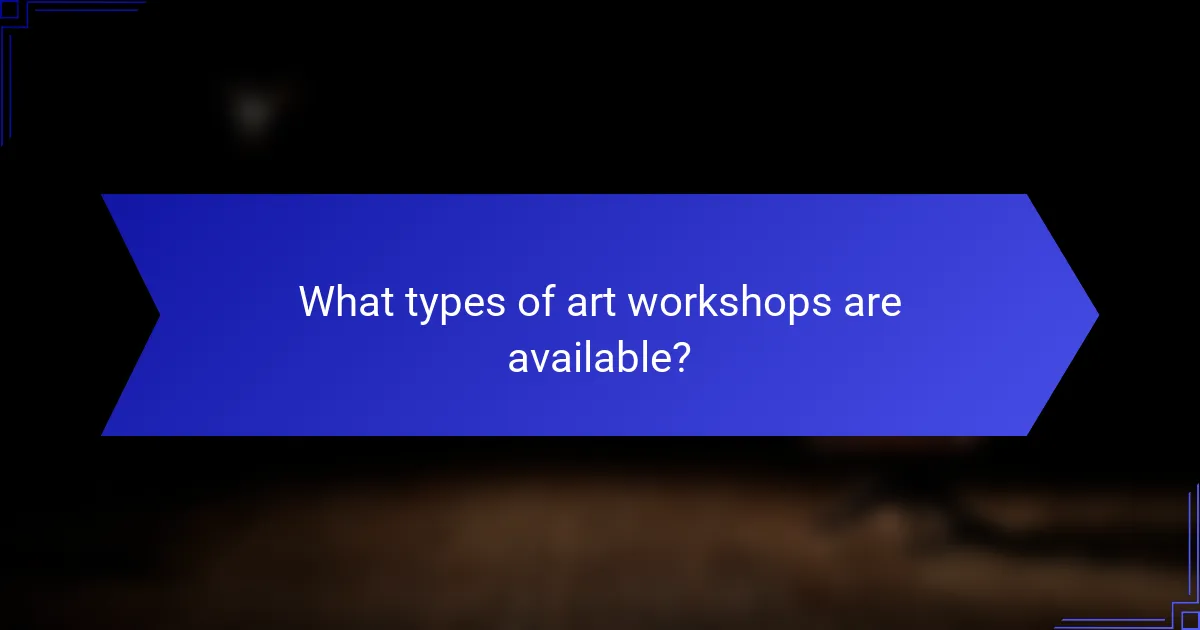
What types of art workshops are available?
Art workshops come in various forms, each focusing on different mediums and techniques. Participants can engage in hands-on experiences that foster creativity and skill development in areas like painting, photography, and sculpture.
Painting workshops
Painting workshops typically cover techniques in various styles, such as watercolor, acrylic, or oil painting. These sessions often cater to different skill levels, from beginners to advanced artists, allowing participants to explore their creativity while learning essential techniques.
When selecting a painting workshop, consider the instructor’s expertise and the materials provided. Many workshops include all necessary supplies, while others may require participants to bring their own. Look for workshops that offer a supportive environment to enhance learning and collaboration.
Photography workshops
Photography workshops focus on both technical skills and artistic vision. Participants learn about camera settings, composition, lighting, and post-processing techniques. These workshops can range from basic photography for beginners to specialized classes like portrait or landscape photography.
Before enrolling, check if the workshop includes practical assignments or field trips, which can significantly enhance learning. Additionally, consider workshops that provide feedback on participants’ work, as constructive criticism can help improve skills and artistic expression.
Sculpture workshops
Sculpture workshops introduce participants to various materials and techniques, such as clay modeling, metalworking, or wood carving. These workshops often emphasize hands-on experience, allowing participants to create their own sculptures while learning about form, texture, and structure.
When choosing a sculpture workshop, evaluate the types of materials used and the instructor’s background. Some workshops may focus on specific styles, like abstract or realistic sculpture, so select one that aligns with your interests. Ensure the workshop provides adequate tools and safety equipment to facilitate a productive and safe learning environment.
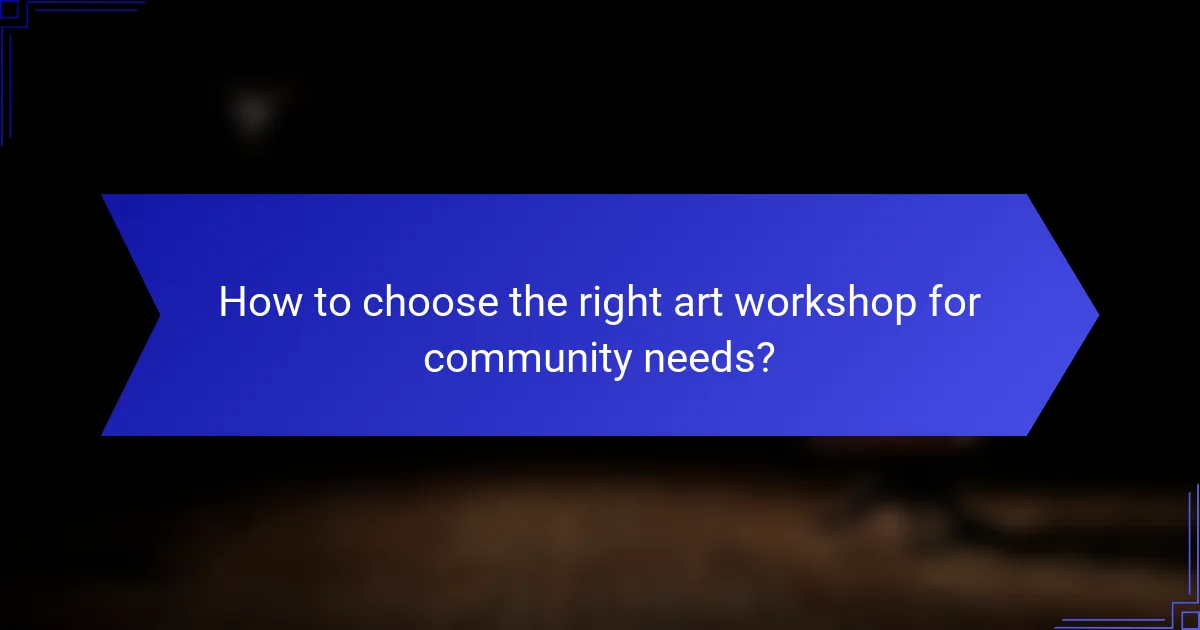
How to choose the right art workshop for community needs?
Choosing the right art workshop involves understanding the specific interests and needs of the community. This ensures that the workshop is relevant, engaging, and beneficial for participants.
Assessing local interests
Start by gathering information about the artistic preferences and cultural backgrounds of the community. Conduct surveys or hold informal discussions to identify popular art forms, such as painting, sculpture, or digital art.
Consider organizing focus groups to dive deeper into specific interests. This can help in tailoring the workshop content to align with what the community finds meaningful and enjoyable.
Evaluating workshop facilitators
Look for facilitators who have experience in the relevant art forms and a strong track record of community engagement. Check their portfolios and past workshop reviews to gauge their effectiveness in teaching and connecting with participants.
It’s beneficial to choose facilitators who are not only skilled artists but also possess strong communication and interpersonal skills. This combination can foster a more inclusive and supportive workshop environment.
Considering accessibility options
Ensure that the workshop venue is accessible to all community members, including those with disabilities. This includes physical access, such as ramps and seating arrangements, as well as providing materials in various formats.
Consider offering workshops at different times or locations to accommodate diverse schedules. Additionally, providing financial assistance or sliding scale fees can help ensure that cost does not become a barrier to participation.
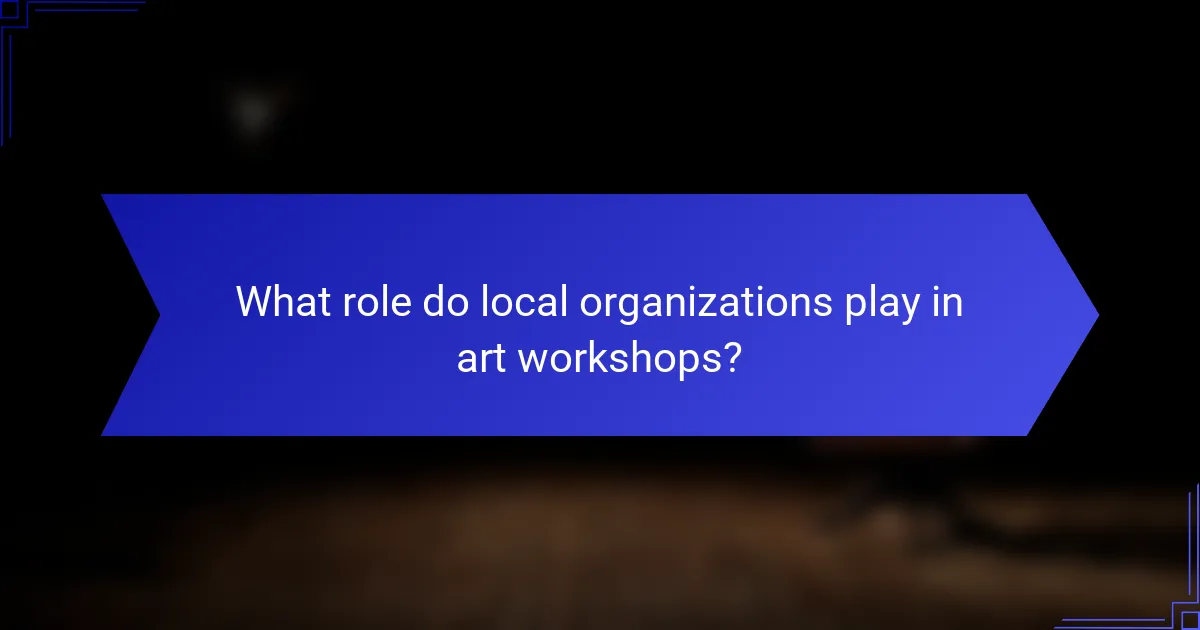
What role do local organizations play in art workshops?
Local organizations are crucial in facilitating art workshops by providing resources, expertise, and community connections. They help create a supportive environment that fosters creativity and collaboration among participants.
Partnerships with schools
Schools often partner with local organizations to enhance their art programs. These collaborations can include hosting workshops on campus, where students engage with professional artists and learn new techniques. Such partnerships not only enrich the curriculum but also promote student involvement in the arts.
For effective partnerships, schools should identify local artists and organizations that align with their educational goals. Regular communication and planning can ensure that workshops meet the needs of both students and educators.
Collaboration with non-profits
Non-profit organizations play a significant role in organizing art workshops that focus on community engagement and social issues. They often provide funding, materials, and facilitators to ensure the workshops are accessible to diverse populations.
Collaborating with non-profits can help art workshops reach underserved communities. It’s beneficial for organizers to align their workshop themes with the missions of these non-profits, creating a shared vision that enhances the impact of the programs.
Support from local businesses
Local businesses can offer vital support for art workshops by providing sponsorship, materials, or venues. This support not only helps reduce costs but also fosters community goodwill and engagement.
To attract local business support, workshop organizers should clearly outline the benefits for businesses, such as visibility in promotional materials or opportunities for employee involvement. Building strong relationships with local enterprises can lead to ongoing partnerships that benefit both parties.
